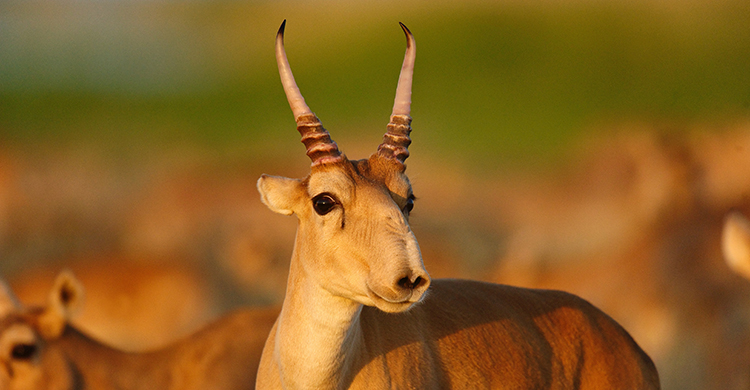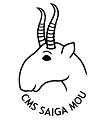New International Conservation Actions Agreed for Saiga Antelopes

Saiga Antelope © P. Romanow
PRESS RELEASE
Bonn, 27 October 2021 - Kazakhstan, Mongolia, the Russian Federation, and Uzbekistan agreed on new joint conservation measures to conserve the Saiga Antelope under the United Nations’ Convention on the Conservation of Migratory Species of Wild Animals (CMS). For the next five years, the international Work Programme for the Saiga Antelope will provide a new framework to conserve and sustainably use the species throughout its migratory range.
The new Work Programme was agreed at the Fourth Meeting of the Signatory States to the CMS Memorandum of Understanding concerning Conservation, Restoration and Sustainable Use of the Saiga Antelope (Saiga MOU) held online on 28 - 29 of September 2021.
The agreed Work Programme considers different approaches to Saiga conservation depending on the individual status of the species in the four range states. While the population is dwindling in Uzbekistan, it has increased tenfold in Kazakhstan since 2015. In both Mongolia and Russia populations are increasing but still remain low.
CMS Executive Secretary Amy Fraenkel said: “The adoption of the new Work Programme by the four Saiga Range States underscores the importance of transboundary conservation. The seasonal migrations of the Saiga Antelope show why ecological connectivity - the unimpeded movement of wild species - is so vital.”
The Meeting also endorsed the report “Sustainable Use of the Saiga Antelope: Perspectives and Prospects”, prepared by the Saiga Conservation Alliance with the financial support of the German Federal Agency for Nature Conservation (BfN) and the Federal Ministry for the Environment, Nature Conservation, Nuclear Safety and Consumer Protection (BMUV) on behalf of the CMS Secretariat, in close consultations with all Range States.
The most recent population counts have shown an increase in Saiga numbers in three Range States, and especially in Kazakhstan, where the total population of Saigas has increased from about 83,000 in 2015 to 842,000 in 2021.
The conservation efforts of the Range States, scientific institutions, and NGOs facilitated by the CMS and CITES Secretariats have played a significant role in this positive dynamic. Range States and NGOs reported on current conservation programmes, including anti-poaching efforts that were stepped up in recent years.
Yet, threats to Saigas, such as wildlife disease, poaching, human-wildlife conflict and barriers to migration persist and can have devastating effects, especially in smaller populations. Over the next five years, Governments will continue to address these threats.
Saiga Antelopes rely on their ability to migrate over large distances to avoid unfavorable weather conditions and are prone to mass die-off events. In 2015 about 200,000 Saiga antelopes perished due to a combination of disease and extreme weather events.
The meeting was organized by the CMS Secretariat and hosted by the Ministry of Natural Resources and Environment of the Russian Federation.
Mr Sergey Anoprienko, Deputy Minister of Natural Resources and Environment of the Russian Federation and Chair of the meeting, said: “Conservation and sustainable use of the Saiga Antelope is an important issue for Russia, considering that the species is included in the Russian Red book. Thanks to the conservation efforts undertaken by the Russian Federation, the number of the Pre-Caspian Saiga population in Russia increased from 3,500 in 2015 to currently 10,000 animals.”

Notes for Editors:
Medium-Term International Work Programme for the Saiga Antelope (2021 - 2025) [EN, RU]: https://www.cms.int/saiga/en/document/medium-term-international-work-programme-saiga-antelope-2021-2025
Report on The sustainable Use of Saiga Antelopes: Perspectives and Prospects [EN, RU]: https://www.cms.int/saiga/en/publication/sustainable-use-saiga-antelopes-perspectives-and-prospects
About the Convention on the Conservation of Migratory Species of Wild Animals (CMS)
An environmental treaty of the United Nations, the Convention on the Conservation of Migratory Species of Wild Animals (CMS) provides a global platform for the conservation and sustainable use of migratory animals and their habitats. This unique treaty brings governments and wildlife experts together to address the conservation needs of terrestrial, aquatic, and avian migratory species and their habitats around the world. Since the Convention's entry into force in 1979, its membership has grown steadily to include 132 Parties from Africa, Central and South America, Asia, Europe and Oceania.
Visit: cms.int
About the CMS Memorandum of Understanding concerning Conservation, Restoration and Sustainable Use of the Saiga Antelope (Saiga MOU)
The CMS Saiga MOU is the only international instrument for the conservation of the Critically Endangered Saiga antelope. The MOU is a legally non-binding international instrument, which has been in force since 2006 and has been signed by all five Range States – Kazakhstan, Mongolia, the Russian Federation, Turkmenistan and Uzbekistan. The MOU aims to achieve and maintain a favourable conservation status for saigas based on the best available scientific information and taking into account the socio-economic value of saigas for the people of various countries.
Visit: cms.int/saiga
Social Media Accounts:
https://twitter.com/BonnConvention
https://www.facebook.com/bonnconvention
https://www.linkedin.com/company/convention-migratory-species/
For more information please contact:
Veronika Lenarz, Senior Public Information Assistant, [email protected]
Last updated on 06 July 2022


